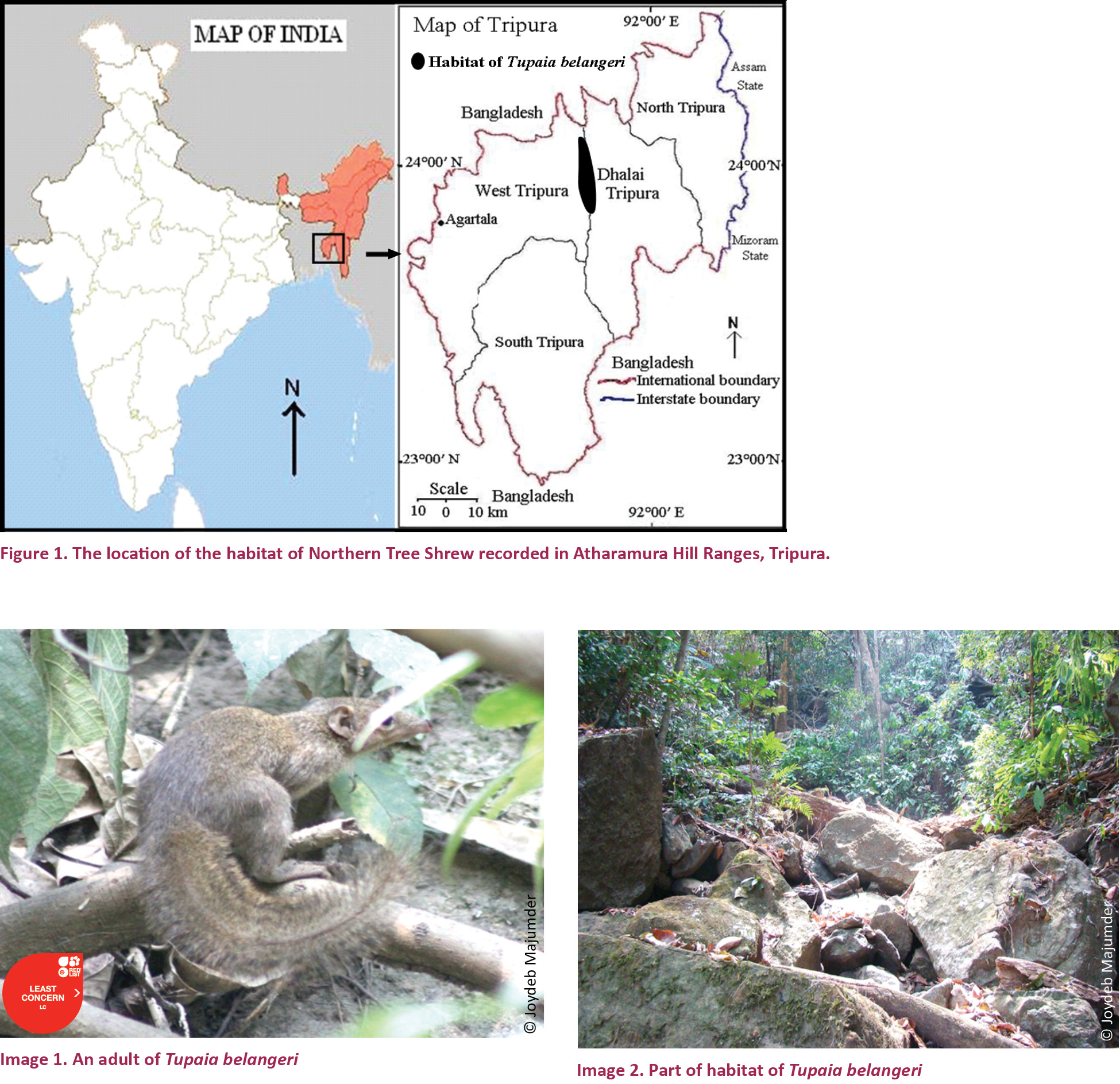Notes on the distribution, habitat, and behavior of Northern Tree Shrew Tupaia belangeri (Mammalia: Scandentia: Tupaiidae) in Tripura, India
Joydeb Majumder 1 & B.K. Agarwala 2
1,2 Ecology and Biodiversity Laboratories, Department of Zoology, Tripura University, Suryamaninagar, Tripura 799022, India
1 jmtugemo@gamil.com, 2 bagarwala00@gmail.com (corresponding author)
doi: http://dx.doi.org/10.11609/JoTT.o3956.6841-2 | ZooBank: urn:lsid:zoobank.org:pub:AC01762A-1E70-42DB-8E45-6A546B1C3DF2
Editor: Anonymity requested. Date of publication: 26 January 2015 (online & print)
Manuscript details: Ms # o3956 | Received 01 March 2014 | Final received 03 September 2014 | Finally accepted 15 December 2014
Citation: Majumder, J. & B.K. Agarwala (2015). Notes on the distribution, habitat, and behavior of Northern Tree Shrew Tupaia belangeri (Mammalia: Scandentia: Tupaiidae) in Tripura, India. Journal of Threatened Taxa 7(1): 6841–6842; http://dx.doi.org/10.11609/JoTT.o3956.6841-2
Copyright: © Majumder & Agarwala 2015. Creative Commons Attribution 4.0 International License. JoTT allows unrestricted use of this article in any medium, reproduction and distribution by providing adequate credit to the authors and the source of publication.
Funding: This study was partly supported by Indian Council of Agricultural Research, New Delhi through a project no.
F.No. 16-16/2007-IA IV to the corresponding author (B.K. Agarwala).
Competing Interest: The authors declare no competing interests.
Acknowledgements: Thanks are extended to Dr. N.S. Prasant and Dr. S. Molur for confirming the identification of the tree shrew species and invaluable information, and to Sri Nimesh Ved for providing related literature.

Tree Shrews are small insectivores of the order Scandentia. Among them, the Northern Tree Shrew Tupaia belangeri (Wagner, 1841) is endemic to the Indo-Burma Biodiversity Hotspot (Han et al. 2008), widely distributed in the tropical deciduous forests of northeastern India (Assam, Meghalaya, Manipur, Mizoram, Nagaland and Sikkim) (Das et al. 1995; Bhattacharyya & Ghosh 2002; Ved 2011), eastern Nepal, Bangladesh, southeastern China, Indo-china, and the Malay Peninsula of the Oriental realms (Oommen & Shanker 2008) with Yunnan-Kweichow Plateau being its northern limit (Wang et al. 1991). Bhattacharyya & Ghosh (2002) recorded this species from western and northern districts of Tripura but did not provide any collection detail. In course of a routine field study at Atharamura Hill Ranges, northern circle of Tripura State in northeastern India (23055’32.8”N & 91057’20.08”E; 322m; Fig. 1), three adults of Northern Tree Shrew (Image 1) were sighted feeding on the forest floor along a seasonal stream at about 06.00hr of 15 March 2012. This is the first record of the species from Dhalai District of Tripura. The salient features of the wild habitat comprised of tropical moist deciduous forest dominated by diverse trees, bamboo brakes and streams in hills and valleys (Image 2).

Close examinations of the day-long behavior lasting 10 hours between 06.00hr and ending at 16.00hr of the three specimens suggested that this species live as solitary individuals and are smart foragers of insects on the ground as well as in trees. Unlike the Nicobar Tree Shrew which is highly arboreal (Oommen & Shanker 2008), most of the time shrews were found to forage on the ground digging out insects from leaf litter and underneath the soil which supported communities of mole crickets, dung beetles, earwigs, tiger beetles, termites, and cockroaches. Periodically, they moved along tree branches and were seen to feed on fruits or seeds or insects like cicadas, wood boring beetles, bark beetles, ants, leaf hoppers, and leaf beetles. This behavior continued up to noon followed by a period of rest for 1–2 hr in nests located in the upper branches of trees. No mating behavior or any fruiting tree was observed. Bamboos in the habitat possibly provided the escape sites from predators like snakes, which are common in the habitat of this mammal.
The Northern Tree Shrew is listed as Least Concern (LC) species in IUCN Red List (Han et al. 2008) and in CITES Appendix II (UNEP-WCMC 2001). However, forest encroachment for collection of timber and fuel wood, land modification for construction of railway track and road network, and conversion of forest land to rubber plantation are the major threats to the wild habitats of this mammal.
References
Bhattacharyya, T.P. & M.K. Ghosh (2002). Mammalia. Fauna of Tripura. Part I. Zoological Survey of India 7: 31–46.
Das, P.K., R.K. Ghosh, T.K. Chakraborty, T.P. Bhattacharyya & M.K. Ghosh (1995). Mammalia. State Fauna Series: Fauna of Meghalaya. Part I. Zoological Survey of India 4: 23–128.
Han, K.H., J.W. Duckworth & S. Molur (2008). Tupaia belangeri. In: IUCN 2011. IUCN Red List of Threatened Species. Version 2011.2. www.iucnredlist.org>. Downloaded on 12 May 2011.
Oommen, M.A. & K. Shanker (2008). Ecology and behaviour of an endemic Tree Shrew Tupaia nicobarica Zelebor, 1869 on Great Nicobar Island, India. Journal of the Bombay Natural History Society 105(1): 55–63.
UNEP-WCMC (2001). Checklist of mammals listed in the CITES Appendices and in the Annexes of the Council of the European Union Regulation (EC) No. 338/97. 5th Edn. JNCC Reports. No. 293.
Ved, N. (2011). Northern Tree shrew Tupaia belangeri in Southern Mizoram, India. Journal of the Bombay Natural History Society 108(2): 132.
Wang, Y.X., C.Y. Li & S.L. Ma (1991). The classification and ecology of Tree Shrew, pp. 21–70. In: Biology of Tree Shrews. Yunnan Scientic and Technological Press, Kunming.